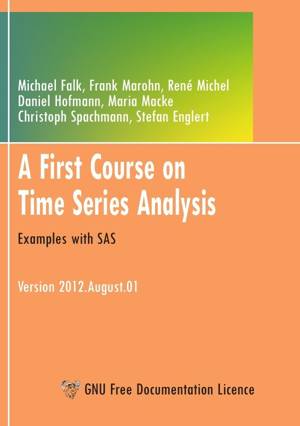
Je cadeautjes zeker op tijd in huis hebben voor de feestdagen? Kom langs in onze winkels en vind het perfecte geschenk!
- Afhalen na 1 uur in een winkel met voorraad
- Gratis thuislevering in België vanaf € 30
- Ruim aanbod met 7 miljoen producten
Je cadeautjes zeker op tijd in huis hebben voor de feestdagen? Kom langs in onze winkels en vind het perfecte geschenk!
- Afhalen na 1 uur in een winkel met voorraad
- Gratis thuislevering in België vanaf € 30
- Ruim aanbod met 7 miljoen producten
Zoeken
€ 29,45
+ 58 punten
Omschrijving
A First Course on Time Series Analysis links up elements from time series analysis with a selection of statistical procedures used in general practice including the statistical software package SAS. Consequently this book addresses students of statistics as well as students of other branches such as economics, demography and engineering, where lectures on statistics belong to their academic training. But it is also intended for the practician who, beyond the use of statistical tools, is interested in their mathematical background. Numerous problems illustrate the applicability of the presented statistical procedures, where SAS gives the solutions. The programs used are explicitly listed and explained. No previous experience is expected neither in SAS nor in a special computer system so that a short training period is guaranteed.
This book is meant for a two semester course (lecture, seminar or practical training) where the first three chapters can be dealt within the first semester. They provide the principal components of the analysis of a time series in the time domain. Chapters 4, 5 and 6 deal with its analysis in the frequency domain and can be worked through in the second term. In order to understand the mathematical background some terms are useful such as convergence in distribution, stochastic convergence, maximum likelihood estimator as well as a basic knowledge of the test theory, so that work on the book can start after an introductory lecture on stochastics. Each chapter includes exercises. An exhaustive treatment is recommended. Chapter 7 (case study) deals with a practical case and demonstrates the presented methods. It is possible to use this chapter independent in a seminar or practical training course, if the concepts of time series analysis are already well understood.
This book is consecutively subdivided in a statistical part and an SAS-specific part. For better clearness the SAS-specific parts are highlighted.
http://statistik.mathematik.uni-wuerzburg.de/timeseries/
This book is meant for a two semester course (lecture, seminar or practical training) where the first three chapters can be dealt within the first semester. They provide the principal components of the analysis of a time series in the time domain. Chapters 4, 5 and 6 deal with its analysis in the frequency domain and can be worked through in the second term. In order to understand the mathematical background some terms are useful such as convergence in distribution, stochastic convergence, maximum likelihood estimator as well as a basic knowledge of the test theory, so that work on the book can start after an introductory lecture on stochastics. Each chapter includes exercises. An exhaustive treatment is recommended. Chapter 7 (case study) deals with a practical case and demonstrates the presented methods. It is possible to use this chapter independent in a seminar or practical training course, if the concepts of time series analysis are already well understood.
This book is consecutively subdivided in a statistical part and an SAS-specific part. For better clearness the SAS-specific parts are highlighted.
http://statistik.mathematik.uni-wuerzburg.de/timeseries/
Alleen bij Standaard Boekhandel
+ 58 punten op je klantenkaart van Standaard Boekhandel
Beoordelingen
We publiceren alleen reviews die voldoen aan de voorwaarden voor reviews. Bekijk onze voorwaarden voor reviews.










